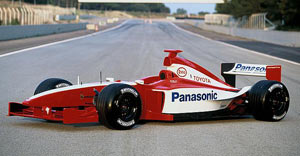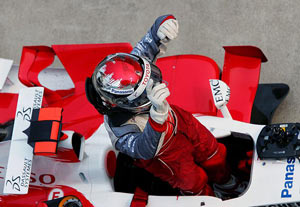Toyota Motorsports GmbH
Founded: 1999 (active 2002 - 2009) Website: http://www.toyota-f1.com/ Principal: Tsutomu Tomita (Jan 2004-June 2007), Tadashi Yamashina (July 2007-2009) Advisor: Ove Andersson (2005-2007) Technical Director Chassis: Mike Gascoyne (2004-2005) General Senior Manager Chassis: Pascal Vasselon (2005-2009) Chief Designer: Gustav Brunner (1999-2005) Technical Director Engine: Luca Marmorini (1999-Jan 2009) Chief Race engineer: Norbert Kreyer (2001-2004), Dieter Gass (2005-2009) Team manager: Ange Pasquali (2002-2004), Richard Cregan (2005-Nov 2008) |
 Car manufacturer Toyota decided in January 1999 that it was time to broaden its horizons to F1. Toyota had had several successes in Rally and at the 24 hours of Le Mans. The team builds ambitiously towards the top of Formula One in a widely known long term vision. The start of the team was accompanied by the building of a brand new factory in Cologne, accompanied with a 50% scale windtunnel. The first car was introduced March 23 of 2001 at the Paul Ricard circuit in Southern France. The team travelled to 11 different grand prix' around the world a tested intensively with Alan McNish and Mika Salo to be well prepared for F1.
Car manufacturer Toyota decided in January 1999 that it was time to broaden its horizons to F1. Toyota had had several successes in Rally and at the 24 hours of Le Mans. The team builds ambitiously towards the top of Formula One in a widely known long term vision. The start of the team was accompanied by the building of a brand new factory in Cologne, accompanied with a 50% scale windtunnel. The first car was introduced March 23 of 2001 at the Paul Ricard circuit in Southern France. The team travelled to 11 different grand prix' around the world a tested intensively with Alan McNish and Mika Salo to be well prepared for F1.
2002 was their first official year in the FIA Formula One series. Despite the testing, the team had a hard time in their first year where they scored two points, good for the last place in the constructors ranking. However, the team has been gradually improving its performances in the first 3 years they competed in F1, while also attracting new top designers, with in 2002 Gustav Brunner from Minardi and later on in 2004 they signed Mike Gascoyne who left the rising Renault team.
The reinforcement of Gascoyne was highly needed at the time, as the team was aiming far higher than its performance so far. In August 2004, Toyota announced to fire second driver Christiano Da Matta in favour of proven race winner Jarno Trulli who came over from Renault. Within the factory, Norbert Kreyer and Ange Pasquali were fired from the team for restructuing purposes. Half a year later, in Januari 2005, Pasquali would win a court case proving that his firing was unjustified.
 Toyota made a highly impressive start to the 2005 season. Trulli was able to show the car's pace by qualifying second for the Australian Grand Prix and finishing in second at the following two races. The results started to fade away through the season as the team was unable to keep up with the pace of development of the rival teams, mainly being McLaren and Renault. All in all, it was the best year for the team during its F1 history as it scored points in every race but the opening GP and the 6-car US Grand Prix at Indianapolis.
Toyota made a highly impressive start to the 2005 season. Trulli was able to show the car's pace by qualifying second for the Australian Grand Prix and finishing in second at the following two races. The results started to fade away through the season as the team was unable to keep up with the pace of development of the rival teams, mainly being McLaren and Renault. All in all, it was the best year for the team during its F1 history as it scored points in every race but the opening GP and the 6-car US Grand Prix at Indianapolis.
While the team kept its drivers for the 2006 season, it was going to be a totally different story. The beginning of the season was marked by the departure of Mike Gascoyne. Despite having had his influence on the uprise of the team, a dispute over the future of the team with team president John Howett eventually cost him his job. The team also decided to switch to Bridgestone tyres, a decision that looked highly unlogical but was considered part of Toyota's long term strategy. Contrary to 2005, the early races were very difficult for the team but with the introduction of the Toyota TF106B things began to run better with an upward pace but yet not enough reliability. The team ended the season in 6th place, with a single third place finish as the best finish of the year.
2007 saw the team further slide down the picking order, as the Toyota TF107 was especially lacking aerodynamic efficiency. While there was adequate downforce, the drag prevented the car from being fast where it should be. All through the year, Ralf Schumacher struggled with the car and eventually retired as Toyota did not want to extend his contract. Two 6th places and 6th in the constructors' standings was all that was possible.
The year after that was promising beforehand as the team chose to hire Timo Glock to partner Jarno Trulli. Glock had won the GP2 season the year before and showed promise during winter testing. It was also immediately apparent that the Toyota TF108 was a vast improvement to 2007. The team eventually ended the championship in 5th place, totalling 56 points with Glock's second place finish at the Hungarian GP the highpoint of the season.
As 2009 came along, clouds started to loom over Cologne, Toyota Racing's headquarters. Rumours that the team might quit F1 were never far away amidst the discussions between some teams, the FIA and later also FOTA. Its head of engines, Luca Marmorini left the team as early as January 15, 2009, only to end up at Ferrari in October.
Because they were one of only 3 teams to have a double diffuser, Toyota had a great start to the season, coming close to victory at Bahrain where strategy cost Trulli dearly. When the season drew to a close, Toyota declined to extend its drivers' contracts, further suggesting a withdrawal.
It was however only on November 4, 2009 that Toyota officially drew the line and ended its 7-year, win-less Formula One campaign in order to cut costs in the financial economic crisis. In Toyota's last season, Jarno Trulli, Timo Glock and Kamui Kobayashi (the last 2 races as Glock was injured in a qualifying crash at Suzuka) scored a total of 59.5 points, ending once more 5th in the constructor's championship.
Cars
| Car designation | Race years |
|---|---|
| Toyota TF101 | 2001 |
| Toyota TF102 | 2002 |
| Toyota TF103 | 2003 |
| Toyota TF104 | 2004 |
| Toyota TF104B | 2004 |
| Toyota TF105 | 2005 |
| Toyota TF105B | 2005 |
| Toyota TF106 | 2006 |
| Toyota TF106B | 2006 |
| Toyota TF107 | 2007 |
| Toyota TF108 | 2008 |
| Toyota TF109 | 2009 |
| Toyota TF110 | 2010 |
